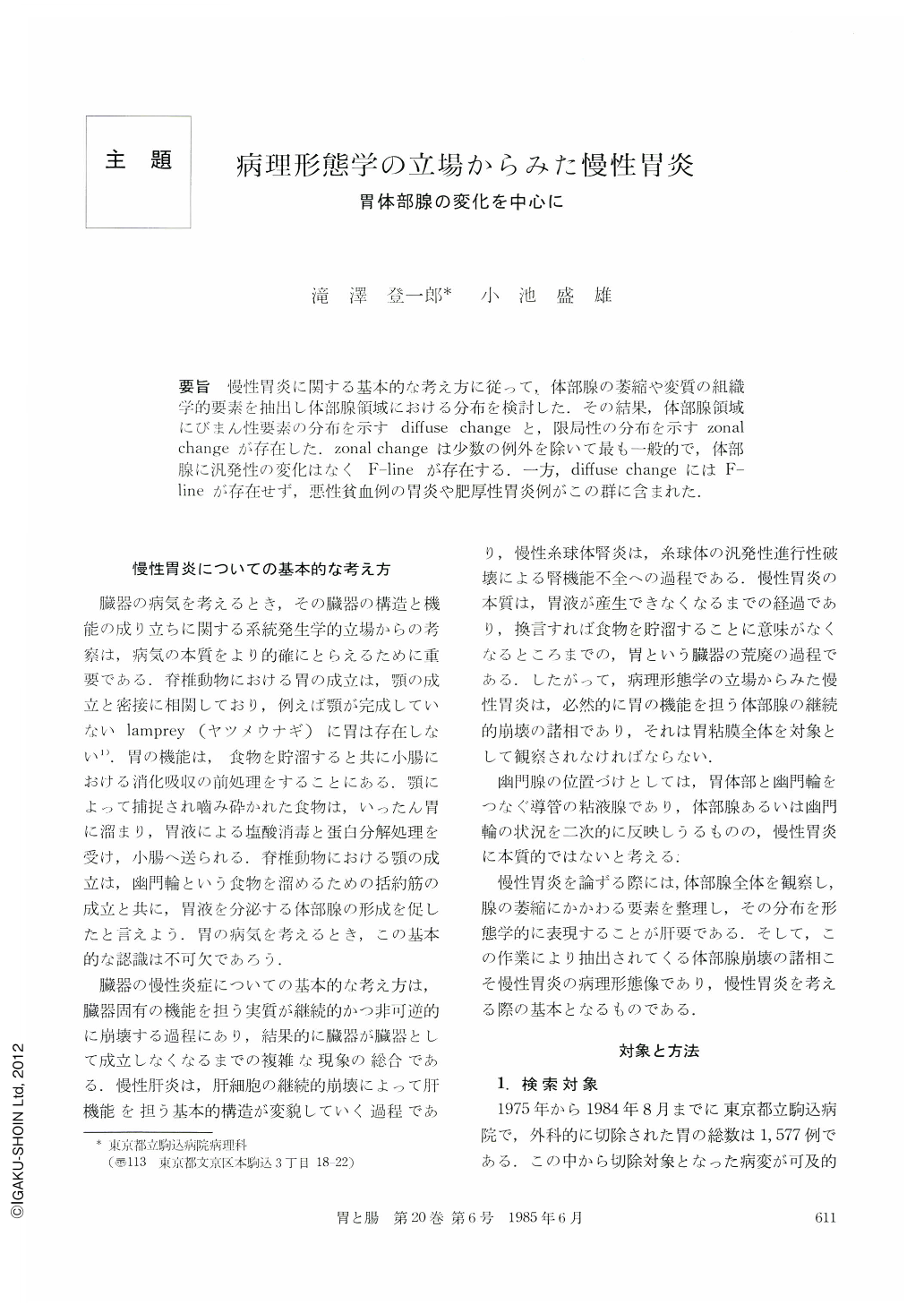Japanese
English
- 有料閲覧
- Abstract 文献概要
- 1ページ目 Look Inside
- サイト内被引用 Cited by
要旨 慢性胃炎に関する基本的な考え方に従って,体部腺の萎縮や変質の組織学的要素を抽出し体部腺領域における分布を検討した.その結果,体部腺領域にびまん性要素の分布を示すdiffuse changeと,限局性の分布を示すzonal changeが存在した.zonal changeは少数の例外を除いて最も一般的で,体部腺に汎発性の変化はなくF-lineが存在する.一方,diffuse changeにはF-lineが存在せず,悪性貧血例の胃炎や肥厚性胃炎例がこの群に含まれた.
Chronic inflammation of an organ signifies irreversible course of progressive devastation of parenchyma which possesses the organ-specific function. In this concept, chronic gastritis means progressive destruction of corpus gland. Pyloric canal of the stomach may be compared to an efferent duct for corpus as an exocrine gland. In the present study, surgically resected 15 stomachs were examined, which were chosen from 1,577 cases in the last 10 years of Tokyo Metropolitan Komagome Hospital. In addition to 15 cases, two cases with pernicious anemia were examined. Whole gastric mucosa of each material was microscopically examined. Four histopathological elements in gastric mucosa; typical intestinal metaplasia, non-typical intestinal metaplasia, pseudopyloric gland metaplasia or mucus neck cell hyperplasia in corpus gland area and lymphoid follicle were mapped. Epithelial change of typical intestinal metaplasia means well developed brush border and appearance of Paneth cell, though non-typical intestinal metaplasia implies ill-developed brush border and no Paneth cell.
The pathological changes of corpus gland mucosa in chronic gastritis are calssified into five patterns; 1) diffuse atrophy with extensive intestinal metaplasia, 2) diffuse spotty and scattered pseudopyloric gland metaplasia or mucus neck cell hyperplasia with giant folds (Ménétrier's disease) or without giant folds, 3) zonal spotty and scattered pseudopyloric gland metaplasia or mucus neck cell hyperplasia with or without giant folds, 4) zonal atrophy with intestinal metaplasia, 5) diffuse and zonal mixed changes. Three fundamental patterns of corpus gland atrophy are recognized; diffuse change, zonal change and mixed change. Diffuse change signifies chronic pancorpus gastritis. Chronic gastritis of pernicious anemia is a prototype of diffuse atrophy. In a case of diffuse atrophy, multiple foci of microcarcinoid tumor were detceted in corpus gland area. This is a interesting case in consideration of etiological relation between chronic gastritis and epithelial neoplasm.
As another type of diffuse change, there are some cases with diffuse distribution of spotty and scattered pseudopyloric gland metaplasia or mucus neck cell hyperplasia. Gross appearances of giant folds are characteristic for the stomach with these diffuse changes. Polyadenomes en nappe, described by Ménétrier is such a typical case. Giant hypertrophic gastritis by Palmer and some cases of chronic hypertrophic gastritis by Schindler are also classified in this group. The stomach with above-mentioned diffuse changes is very rare. However, in true sense of chronic gastritis; pan-corpus gastritis, the stomachs of pernicious anemia and of chronic hypertrophic gastritis (Ménétrier's disease) are prototypes of chronic gastritis. In principle, there is no remarkable atrophy of pyloric gland mucosa of the stomach with pancorpus gastritis.
On the contrary, zonal chage with intestinal metaplasia is the commonest finding on the stomach, we routinely examine. In such a stomach, no diffuse change is detectable in corpus gland area and we can recognize so-called F-line. There is also considerable intestinal metaplasia in pyloric gland area of the stomach with such zonal change. A stomach with ordinary zonal change should be called as a stomach with chronic exogenous gastritis, because exogenous factors play a main etiological role in making such condition. On the other hand, a stomach with diffuse change of pan-corpus gastritis should be called as chronic endogenous gastritis. Some endogenous factors play an important role in making this pathological state.

Copyright © 1985, Igaku-Shoin Ltd. All rights reserved.


